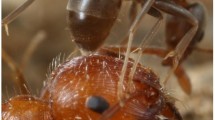Abstract
The role of postpharyngeal gland secretion in nestmate recognition was tested inManica rubida. Behavioral tests comprised two consecutive encounters between five ants and their color-marked nestmate. The first encounter utilized an untreated ant constituting a control, whereas in the second encounter the marked ant was treated with postpharyngeal gland exudate. Scoring was done using an aggression index obtained by direct observation and an agitation index deduced from a frame-by-frame analysis of videotapes of the various tests. When the glandular secretion originated from an alien ant, the ants became very agitated and were aggressive toward their nestmate. When the exudate originated from a nestmate, the ants generally remained calm, although their rates of self-grooming increased.
Similar content being viewed by others
References
Bagnères, A.-G., and Morgan, E. D. (1991). The postpharyngeal glands and the cuticle of Formicidae contain the same characteristic hydrocarbons.Experientia 47: 106–111.
Bagnères, A.-G., Errard, C., Mulheim, C., Joulie, C., and Lange, C. (1991). Induced mimicry of colony odors in ants.J. Chem. Ecol. 17: 1641–1664.
Bernard, F. (1968).Les fourmis (Hymenoptera, Formicidae) d'Europe occidentale et septentrionale. Faune de l'Europe et du bassin Mediterranéen, Vol. 3, Masson, Paris.
Blum, M. S. (1987). The basis and evolutionary significance of recognitive olfactory acuity in insect societies. In Pasteels, J. M., and Deneubourg, J. L. (eds.),From Individual to Collective Behavior in Social Insects, Birkhauser Verlag, Basel, pp. 277–293.
Bonavita-Cougourdan, A., Clément, J. L., and Lange, C. (1987). Nestmate recognition: The role of cuticular hydrocarbons in the antCamponotus vagus Scop.J. Entomol. Sci. 22: 1–10.
Bonavita-Cougourdan, A., Clément, J. L., and Lange, C. (1989). The role of cuticular hydrocarbons in recognition of larvae by workers of the antCamponotus vagus: Changes in the chemical signature in response to social environment (Hymenoptera: Formicidae).Sociobiology 16: 49–74.
Bradshaw, J. W. S., and Howse, P. E. (1984). Sociochemicals of ants. In Bell, W. J., and Carde, R. T. (eds.),Chemical Ecology of Insects, Chapman & Hall, London, pp. 429–473.
Errard, C. (1994). Development of interspecific recognition behavior in the antsManica rubida andFormica selysi (Hymenoptera: Formicidae) reared in mixed species groups.J. Insect Behav. 7: 83–99.
Hefetz, A., Errard, C., and Cojocaru, M. (1992). The occurrence of heterospecific substances in the postpharyngeal gland secretion of ants reared in mixed species colonies (Hymenoptera: Formicidae).Naturwissenschaften 79: 417–420.
Henderson, G., Andersen, J. F., Phillips, J. K., and Jeanne, R. L. (1990). Internest aggression and identification of possible nestmate discrimination pheromones in polygynous antFormica montana.J. Chem. Ecol. 16: 2217–2228.
Hölldobler, B., and Wilson, E. O. (1990).The Ants, Harvard University Press, Cambridge, MA.
Howse, P. E. (1975). Chemical defenses of ants, termites and other insects: Some outstanding questions. In Noirot, C., Howse, P. E., and Le Masne, G. (eds.),Pheromones and Defensive Secretions in Social Insects, IUSSI, Dijon, France, pp. 23–40.
Nowbahari, E., Lenoir, A., Clément, J. L., Lange, C., Bagnères, A.-G., and Joulie, C. (1990). Individual, geographical and experimental variation of cuticular hydrocarbons of the antCataglyphis cursor (Hymenoptera: Formicidae): Their use in nest and subspecies recognition.Biochem. System. Ecol. 18: 163–173.
Soroker, V., Vienne, C., Nowbahari, E., and Hefetz, A. (1994). The postpharyngeal gland as a Gestalt organ for nestmate recognition in the antCataglyphis niger.Naturwissenschaften 81: 510–513.
Soroker, V., Vienne, C., and Hefetz, A. (1995a). Hydrocarbon dynamics within and between nestmates inCataglyphis niger (Hymenoptera: Formicidae).J. Chem. Ecol. 21: 365–378.
Soroker, V., Hefetz, A., Cojocaru, M., Billen, J., Franke, S., and Francke, W. (1995b). Structural and chemical ontogeny of the postpharyngeal gland of the desert antCataglyphis niger.Physiol. Entomol. 20: 323–329.
Van der Meer, R. K., Saliwanchik, D., and Lavine, B. (1989). Temporal changes in colony cuticular hydrocarbon patterns ofSolenopsis invicta. Implications for nestmate recognition.J. Chem. Ecol. 15: 2115–2125.
Vienne, C., Soroker, V., and Hefetz, A. (1995). Congruency of hydrocarbon patterns in heterospecific groups of ants: Transfer and/or biosynthesis?Insectes Soc. 42: 267–277.
Author information
Authors and Affiliations
Rights and permissions
About this article
Cite this article
Hefetz, A., Errard, C., Chambris, A. et al. Postpharyngeal gland secretion as a modifier of aggressive behavior in the myrmicine antManica rubida . J Insect Behav 9, 709–717 (1996). https://doi.org/10.1007/BF02213551
Revised:
Issue Date:
DOI: https://doi.org/10.1007/BF02213551




